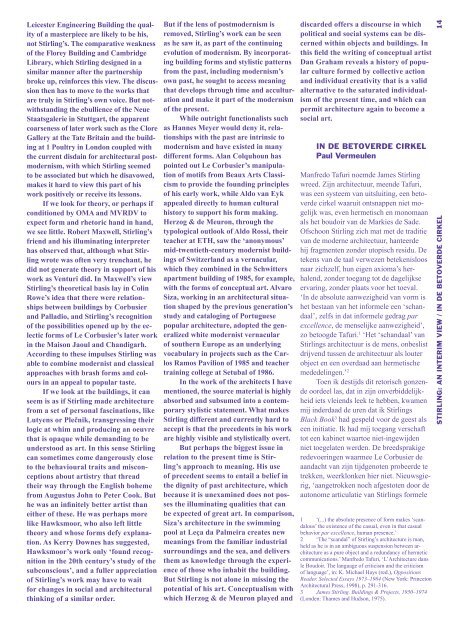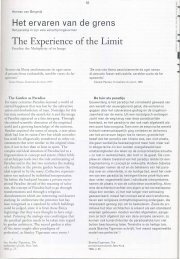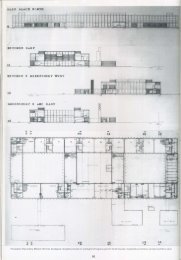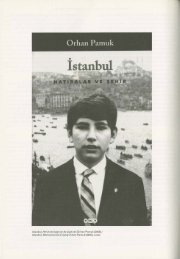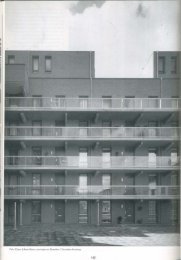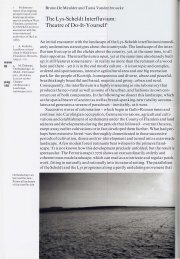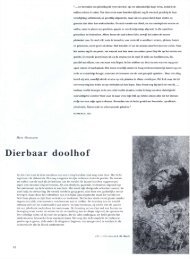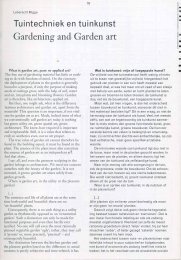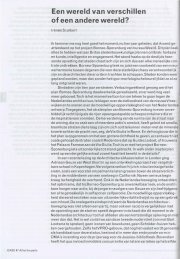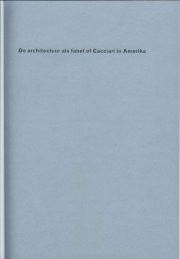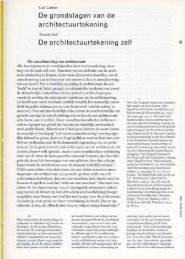Download PDF, 3 pagina's, 307 KB - OASE Journal for Architecture
Download PDF, 3 pagina's, 307 KB - OASE Journal for Architecture
Download PDF, 3 pagina's, 307 KB - OASE Journal for Architecture
Create successful ePaper yourself
Turn your PDF publications into a flip-book with our unique Google optimized e-Paper software.
Leicester Engineering Building the quality<br />
of a masterpiece are likely to be his,<br />
not Stirling’s. The comparative weakness<br />
of the Florey Building and Cambridge<br />
Library, which Stirling designed in a<br />
similar manner after the partnership<br />
broke up, rein<strong>for</strong>ces this view. The discussion<br />
then has to move to the works that<br />
are truly in Stirling’s own voice. But notwithstanding<br />
the ebullience of the Neue<br />
Staatsgalerie in Stuttgart, the apparent<br />
coarseness of later work such as the Clore<br />
Gallery at the Tate Britain and the building<br />
at 1 Poultry in London coupled with<br />
the current disdain <strong>for</strong> architectural postmodernism,<br />
with which Stirling seemed<br />
to be associated but which he disavowed,<br />
makes it hard to view this part of his<br />
work positively or receive its lessons.<br />
If we look <strong>for</strong> theory, or perhaps if<br />
conditioned by OMA and MVRDV to<br />
expect <strong>for</strong>m and rhetoric hand in hand,<br />
we see little. Robert Maxwell, Stirling’s<br />
friend and his illuminating interpreter<br />
has observed that, although what Stirling<br />
wrote was often very trenchant, he<br />
did not generate theory in support of his<br />
work as Venturi did. In Maxwell’s view<br />
Stirling’s theoretical basis lay in Colin<br />
Rowe’s idea that there were relationships<br />
between buildings by Corbusier<br />
and Palladio, and Stirling’s recognition<br />
of the possibilities opened up by the eclectic<br />
<strong>for</strong>ms of Le Corbusier’s later work<br />
in the Maison Jaoul and Chandigarh.<br />
According to these impulses Stirling was<br />
able to combine modernist and classical<br />
approaches with brash <strong>for</strong>ms and colours<br />
in an appeal to popular taste.<br />
If we look at the buildings, it can<br />
seem is as if Stirling made architecture<br />
from a set of personal fascinations, like<br />
Lutyens or Plečnik, transgressing their<br />
logic at whim and producing an oeuvre<br />
that is opaque while demanding to be<br />
understood as art. In this sense Stirling<br />
can sometimes come dangerously close<br />
to the behavioural traits and misconceptions<br />
about artistry that thread<br />
their way through the English boheme<br />
from Augustus John to Peter Cook. But<br />
he was an infinitely better artist than<br />
either of these. He was perhaps more<br />
like Hawksmoor, who also left little<br />
theory and whose <strong>for</strong>ms defy explanation.<br />
As Kerry Downes has suggested,<br />
Hawksmoor’s work only ‘found recognition<br />
in the 20th century’s study of the<br />
subconscious’, and a fuller appreciation<br />
of Stirling’s work may have to wait<br />
<strong>for</strong> changes in social and architectural<br />
thinking of a similar order.<br />
But if the lens of postmodernism is<br />
removed, Stirling’s work can be seen<br />
as he saw it, as part of the continuing<br />
evolution of modernism. By incorporating<br />
building <strong>for</strong>ms and stylistic patterns<br />
from the past, including modernism’s<br />
own past, he sought to access meaning<br />
that develops through time and acculturation<br />
and make it part of the modernism<br />
of the present.<br />
While outright functionalists such<br />
as Hannes Meyer would deny it, relationships<br />
with the past are intrinsic to<br />
modernism and have existed in many<br />
different <strong>for</strong>ms. Alan Colquhoun has<br />
pointed out Le Corbusier’s manipulation<br />
of motifs from Beaux Arts Classicism<br />
to provide the founding principles<br />
of his early work, while Aldo van Eyk<br />
appealed directly to human cultural<br />
history to support his <strong>for</strong>m making.<br />
Herzog & de Meuron, through the<br />
typological outlook of Aldo Rossi, their<br />
teacher at ETH, saw the ‘anonymous’<br />
mid-twentieth-century modernist buildings<br />
of Switzerland as a vernacular,<br />
which they combined in the Schwitters<br />
apartment building of 1985, <strong>for</strong> example,<br />
with the <strong>for</strong>ms of conceptual art. Alvaro<br />
Siza, working in an architectural situation<br />
shaped by the previous generation’s<br />
study and cataloging of Portuguese<br />
popular architecture, adopted the generalized<br />
white modernist vernacular<br />
of southern Europe as an underlying<br />
vocabulary in projects such as the Carlos<br />
Ramos Pavilion of 1985 and teacher<br />
training college at Setubal of 1986.<br />
In the work of the architects I have<br />
mentioned, the source material is highly<br />
absorbed and subsumed into a contemporary<br />
stylistic statement. What makes<br />
Stirling different and currently hard to<br />
accept is that the precedents in his work<br />
are highly visible and stylistically overt.<br />
But perhaps the biggest issue in<br />
relation to the present time is Stirling’s<br />
approach to meaning. His use<br />
of precedent seems to entail a belief in<br />
the dignity of past architecture, which<br />
because it is unexamined does not posses<br />
the illuminating qualities that can<br />
be expected of great art. In comparison,<br />
Siza’s architecture in the swimming<br />
pool at Leça da Palmeira creates new<br />
meanings from the familiar industrial<br />
surroundings and the sea, and delivers<br />
them as knowledge through the experience<br />
of those who inhabit the building.<br />
But Stirling is not alone in missing the<br />
potential of his art. Conceptualism with<br />
which Herzog & de Meuron played and<br />
discarded offers a discourse in which<br />
political and social systems can be discerned<br />
within objects and buildings. In<br />
this field the writing of conceptual artist<br />
Dan Graham reveals a history of popular<br />
culture <strong>for</strong>med by collective action<br />
and individual creativity that is a valid<br />
alternative to the saturated individualism<br />
of the present time, and which can<br />
permit architecture again to become a<br />
social art.<br />
IN DE BETOVERDE CIRKEL<br />
Paul Vermeulen<br />
Manfredo Tafuri noemde James Stirling<br />
wreed. Zijn architectuur, meende Tafuri,<br />
was een systeem van uitsluiting, een betoverde<br />
cirkel waaruit ontsnappen niet mogelijk<br />
was, even hermetisch en monomaan<br />
als het boudoir van de Markies de Sade.<br />
Ofschoon Stirling zich mat met de traditie<br />
van de moderne architectuur, hanteerde<br />
hij fragmenten zonder utopisch residu. De<br />
tekens van de taal verwezen betekenisloos<br />
naar zichzelf, hun eigen axioma’s herhalend,<br />
zonder toegang tot de dagelijkse<br />
ervaring, zonder plaats voor het toeval.<br />
‘In de absolute aanwezigheid van vorm is<br />
het bestaan van het in<strong>for</strong>mele een ‘schandaal’,<br />
zelfs in dat in<strong>for</strong>mele gedrag par<br />
excellence, de menselijke aanwezigheid’,<br />
zo betoogde Tafuri. 1 ‘Het ‘schandaal’ van<br />
Stirlings architectuur is de mens, onbeslist<br />
drijvend tussen de architectuur als louter<br />
object en een overdaad aan hermetische<br />
mededelingen.’ 2<br />
Toen ik destijds dit retorisch gonzende<br />
oordeel las, dat in zijn onverbiddelijkheid<br />
iets vleiends leek te hebben, kwamen<br />
mij inderdaad de uren dat ik Stirlings<br />
Black Book 3 had gespeld voor de geest als<br />
een initiatie. Ik had mij toegang verschaft<br />
tot een kabinet waartoe niet-ingewijden<br />
niet toegelaten werden. De breedsprakige<br />
redevoeringen waarmee Le Corbusier de<br />
aandacht van zijn tijdgenoten probeerde te<br />
trekken, weerklonken hier niet. Nieuwsgierig,<br />
‘aangetrokken noch afgestoten door de<br />
autonome articulatie van Stirlings <strong>for</strong>mele<br />
1 ‘(...) the absolute presence of <strong>for</strong>m makes ‘scandalous’<br />
the existence of the casual, even in that casual<br />
behavior par excellence, human presence.’<br />
2 ‘The “scandal” of Stirling’s architecture is man,<br />
held as he is in an ambiguous suspension between architecture<br />
as a pure object and a redundancy of hermetic<br />
communications.’ Manfredo Tafuri, ‘L’<strong>Architecture</strong> dans<br />
le Boudoir. The language of criticism and the criticism<br />
of language’, in: K. Michael Hays (red.), Oppositions<br />
Reader. Selected Essays 1973–1984 (New York: Princeton<br />
Architectural Press, 1998), p. 291-316.<br />
3 James Stirling. Buildings & Projects, 1950–1974<br />
(Londen: Thames and Hudson, 1975).<br />
14<br />
STIRLING: AN INTERIM VIEW / IN DE BETOVERDE CIRKEL
machines’ 4 begroette ik de veeleisende<br />
klim, de ijlte en de gevaarlijk dunne lucht<br />
die daar hing als een tot overmoed prikkelende<br />
weldaad.<br />
Volkshuisvesting was voor de moderne<br />
architectuur bij uitstek het vehikel<br />
van de utopie. Daarom is in Runcorn,<br />
het uit glimmende panelen gemonteerde<br />
huisvestingsproject van Stirling, de afwezigheid<br />
van utopische residuen zo opvallend.<br />
De typologische en technologische<br />
keuzes stonden vast nog voor Stirling de<br />
opdracht kreeg; hij benaderde de opdracht,<br />
zo stelt Mark Girouard, ‘als een interessant<br />
ontwerpprobleem – hoe een coherent en<br />
treffend geheel produceren met geprefabriceerde<br />
eenheden, voortdurend herhaald<br />
over een groot gebied’. 5 Stirlings marineassociaties<br />
– de ronde ramen – evoceerden<br />
anders dan bij Le Corbusier geen sociale<br />
utopie: het waren louter ‘linguïstische<br />
elementen, of beter voorwendsels voor het<br />
gebruik van taal’. 6 De wraak van de ideologie<br />
op deze gladde <strong>for</strong>mele machine werd<br />
koud geserveerd. Na nog geen twintig jaar<br />
werd ze gesloopt om plaats te maken voor<br />
suburbane twee onder een kap.<br />
Niets hiervan begreep of voorzag ik<br />
toen ik mijn initiatie met het Black Book<br />
doorliep. Maar ik voelde wel dat de wapperende<br />
sjaals en ouderwetse cabrio’s die<br />
Léon Krier in de straten van Runcorn had<br />
getekend een schennis waren, even schril<br />
als de plichtmatige gezelligheid van een<br />
berghut in de ijlte. Stirling zal deze inbreuk<br />
hebben gedoogd als een vroege blijk van de<br />
baldadige nostalgie die hem overviel, net nu<br />
zijn architectuur een perfecte pasvorm had<br />
gevonden voor de consumptiemaatschappij<br />
die nu rap haar verval tegemoet snelde.<br />
Krier zal een voortijdige poging hebben<br />
ondernomen om de soevereine machine in te<br />
lijven in een argument tegen CIAM, voor de<br />
traditionele rooilijnenstad. De autobiografie<br />
(voor Stirling) en de politiek (voor Krier)<br />
waren kiemen van realiteit die het hermetische<br />
kabinet binnendrongen en besmetten.<br />
De bewoners ten slotte, onbeheersbaar en<br />
schandalig, in niets gelijkend op Kriers<br />
flanerende dandy’s, deden de rest.<br />
Een anekdote van Girouard geeft een<br />
prangende illustratie van Tafuri’s punt.<br />
Robert Dutch, gehuwd en vader van twee<br />
kinderen, zorgde voor opschudding door<br />
zich bij herhaling naakt te vertonen in het<br />
verdiepingshoge ronde raam van zijn woning<br />
in Runcorn. Hij nam daarbij theatrale<br />
houdingen aan. ‘Hij leek God wel’, zei de<br />
politieagente die hem arresteerde, maar<br />
Stirling wist beter: met zijn armen gestrekt,<br />
naakt in de grote cirkel leek de man op een<br />
renaissancegravure die de verhoudingen<br />
van de architectuur met het menselijk lichaam<br />
verbond. De soevereine compositie<br />
zegevierde! De zielenpoot, gekooid achter<br />
glas, gevangen in de cirkel, veranderde<br />
zichzelf in een logo van pure architectuur.<br />
Zijn deviant verlangen viel samen met het<br />
schandaal van de autonome vorm. ‘Dit’,<br />
aldus Girouard, ‘was het soort verhaal dat<br />
Jim aan het lachen bracht.’ 7 Voortaan zou<br />
hij naast de autonome vorm de pervertering<br />
ervan te kijk zetten, en zijn <strong>for</strong>mele<br />
machines vergezellen van een vulgair commentaar.<br />
In de inleiding tot zijn biografie van<br />
Stirling breekt Girouard een lans voor de<br />
relevantie van een boek over een architectenleven.<br />
Een architectenleven haalt<br />
zelden de media, terwijl het nochtans een<br />
opwindende zaak dient die op vele levens<br />
ingrijpt. Omdat ikzelf behoor tot de kaste<br />
van architecten las ik zijn boek met een<br />
ietwat ander soort ontroering. Als student<br />
werd ik door het Black Book geïnitieerd<br />
in de wondere esoterie van de productie<br />
van vormen. Als praktizerend architect<br />
echter vond ik troost in dit picareske heiligenleven,<br />
waarin de hoofdpersoon als een<br />
kolossale uitvergroting exemplarisch werd<br />
onderworpen aan de beproevingen van ons<br />
vak. De eredienst voor helden die niemand<br />
kent. De verleiding van het technisch<br />
risico, dat zich als schoonheid vermomt.<br />
De paniek voor de aangetekende brief. Het<br />
ontzag voor en de argwaan jegens de culturele<br />
intelligentsia. De steken van jaloezie<br />
bij het succes van een mindere confrater.<br />
De krenterigheid en bedilzucht van opdrachtgevers.<br />
Architectuur als glijmiddel<br />
en als zondebok. Het meningsverschil met<br />
een dierbare medestander. Een reputatie die<br />
achter je aan stommelt, vaag en groot als<br />
een schaduw. Het wonder van de ruimte dat<br />
zich openbaart in een gebouw in aanbouw.<br />
Boven dit alles: een galmende lach.<br />
De vraag die zich dan opdringt is of<br />
Stirling, tussen canon en vulgariteit, ook<br />
exemplarisch is in zijn onvermogen om<br />
het alledaagse te onthalen. Is de architectuur<br />
in staat tot het gewone? Verdraagt de<br />
autoritaire vorm een andere tegenstem dan<br />
spot en pervertering? Net zoals voor Stirling<br />
blijft vandaag voor ons de grote poort<br />
4 ‘Neither attracted nor repulsed by the independent<br />
articulation of Stirling’s <strong>for</strong>mal machines (...)’ Tafuri, op.<br />
cit. (noot 2).<br />
5 ‘(...) a design problem which interested him – how<br />
to produce a coherent and striking whole out of precast<br />
units constantly repeated over a large area – (...)’ Mark<br />
Girouard, Big Jim. The Life and Work of James Stirling<br />
(Londen: Pimlico, 2000).<br />
6 ‘(...) a linguistic element, or better, (...) a pretext<br />
<strong>for</strong> the use of language’. Manfredo Tafuri, op. cit. (noot 2).<br />
7 ‘It was the kind of story that made Jim laugh.’<br />
Girouard, op. cit. (noot 5).<br />
van de ideologie gesloten. Het sociale<br />
dient zich niet aan als een utopie, maar als<br />
een micropolitieke keuze: bescheidener,<br />
concreter, pertinenter. Menselijke betekenis<br />
glinstert overal. Zelfs als we verkiezen haar<br />
niet te zien, zal ze haar gram halen en onze<br />
onaangedaanheid overstemmen met een<br />
bulderende lach.<br />
INSIDE THE MAGIC CIRCLE<br />
Paul Vermeulen<br />
Manfredo Tafuri called James Stirling<br />
cruel. His architecture, in Tafuri’s opinion,<br />
was a system of exclusion, a magic<br />
circle that offered no escape, as hermetic<br />
and monomaniac as the Marquis de<br />
Sade’s boudoir. Although Stirling saw<br />
himself within the tradition of modern<br />
architecture, he used fragments without<br />
utopian residues. The linguistic signs<br />
were self-referential and meaningless,<br />
repeating their own axioms, without<br />
access to everyday experience, without<br />
room <strong>for</strong> chance. ‘The absolute presence<br />
of <strong>for</strong>m makes “scandalous” the existence<br />
of the casual, even in that casual<br />
behavior par excellence, human presence,’<br />
according to Tafuri.‘The “scandal”<br />
of Stirling’s architecture is man,<br />
held as he is in an ambiguous suspension<br />
between architecture as a pure object<br />
and a redundancy of hermetic communications.’<br />
1<br />
When I first read this rhetorically<br />
rich judgement, which seemed almost<br />
flattering in its implacability, I was reminded<br />
of the many hours I had spent<br />
perusing Stirling’s Black Book; it had<br />
been a kind of initiation. 2 I had gained<br />
access to a cabinet from which the uninitiated<br />
were barred. No echoes here<br />
of the verbose speeches with which Le<br />
Corbusier had tried to catch his contemporaries’<br />
attention. Curious, ‘neither<br />
attracted nor repulsed by the independent<br />
articulation of Stirling’s <strong>for</strong>mal<br />
machines’, 3 I welcomed the demanding<br />
ascent, the emptiness and the dangerously<br />
rarefied air as a salutary incentive to<br />
recklessness.<br />
For modern architecture, public<br />
housing was, above all else, a utopian<br />
vehicle. That makes the absence of any<br />
1 Manfredo Tafuri, ‘L’<strong>Architecture</strong> dans le<br />
Boudoir: The Language of Criticism and the Criticism<br />
of Language’, in: K. Michael Hays (ed.), Oppositions<br />
Reader: Selected Essays 1973-1984 (New York:<br />
Princeton Architectural Press, 1998), 291-316.<br />
2 James Stirling. Buildings & Projects, 1950-1974<br />
(London: Thames and Hudson, 1975).<br />
3 Tafuri, op. cit. (note 1).<br />
<strong>OASE</strong> #79 IN DE BETOVERDE CIRKEL / INSIDE THE MAGIC CIRCLE<br />
15
utopian traces in Runcorn, Stirling’s<br />
sleek panel-clad public housing project,<br />
all the more striking. The typological<br />
and technological decisions had been<br />
made be<strong>for</strong>e Stirling received the<br />
commission; he approached it, Mark<br />
Girouard claims, ‘as a design problem<br />
which interested him – how to produce<br />
a coherent and striking whole out of<br />
precast units constantly repeated over a<br />
large area’. 4 Unlike Le Corbusier, Stirling’s<br />
marine associations – the round<br />
windows – did not evoke a social utopia:<br />
they were purely a ‘linguistic element,<br />
or better . . . a pretext <strong>for</strong> the use of language’.<br />
5 Ideology’s revenge on this slick,<br />
<strong>for</strong>mal machine was served cold. Barely<br />
20 years later, it was demolished to make<br />
way <strong>for</strong> suburban semi-detached homes.<br />
I understood or <strong>for</strong>esaw none of<br />
this during my initiation with the Black<br />
Book. But I did sense that Léon Krier’s<br />
drawings of fluttering scarves and oldfashioned<br />
convertibles in the streets of<br />
Runcorn were a violation, as jarring<br />
as the obligatory cosiness of a chalet<br />
in rarefied mountain air. Stirling must<br />
have put up with this violation like an<br />
early sign of the wayward nostalgia that<br />
hit him, just when his architecture had<br />
found the perfect <strong>for</strong>m <strong>for</strong> a rapidly<br />
declining consumer society. Krier must<br />
have made a premature attempt at annexing<br />
the sovereign machine to an<br />
argument against CIAM and in favour<br />
of traditional building lines. Autobiography<br />
(<strong>for</strong> Stirling) and politics (<strong>for</strong> Krier)<br />
were germs of reality that crept into and<br />
infected the hermetic cabinet. In the end<br />
the residents, ungovernable and scandalous,<br />
and quite unlike Krier’s flâneurs,<br />
did the rest.<br />
An anecdote by Girouard provides<br />
a compelling illustration of Tafuri’s<br />
point. Robert Dutch, married with two<br />
children, caused a stir by repeatedly<br />
appearing naked in the floor-to-ceiling<br />
round window of his home in Runcorn.<br />
Doing so, he would assume theatrical<br />
poses. ‘He looked just like God,’ said<br />
the female police officer who arrested<br />
him. But Stirling knew better: with his<br />
arms outstretched, naked in the large<br />
circle, the man resembled a Renaissance<br />
engraving, placing the human body into<br />
architectural perspective. The sovereign<br />
composition triumphed! The poor<br />
wretch, imprisoned behind glass, caught<br />
in a circle, trans<strong>for</strong>med himself into a<br />
logo of pure architecture. His deviant desire<br />
coincided with the scandal of the autonomous<br />
<strong>for</strong>m. According to Girouard,<br />
‘it was the kind of story that made Jim<br />
laugh’. 6 From then on he would flaunt<br />
the autonomous <strong>for</strong>m as well as its corruption,<br />
and accompany his <strong>for</strong>mal machines<br />
with a vulgar commentary.<br />
In the introduction to his biography<br />
of Stirling, Girouard stands up <strong>for</strong> the<br />
relevance of a book about an architect’s<br />
life. An architect’s life seldom makes the<br />
front pages, although it actually serves<br />
an exhilarating cause with an impact on<br />
many people’s lives. Because I belong to<br />
the caste of architects, his book moved<br />
me in a somewhat different way. As<br />
a student I was initiated by the Black<br />
Book in the wondrous esotericism of<br />
the production of <strong>for</strong>ms. As a practising<br />
architect, however, I found solace in this<br />
picaresque hagiography, in which the<br />
protagonist was served up as a largerthan-life<br />
exemplar and subjected to the<br />
trials and tribulations of our profession.<br />
The worship of unknown heroes.<br />
The temptation of the technical risk<br />
disguised as beauty. The panic of the<br />
registered letter. The veneration <strong>for</strong> and<br />
mistrust of the cultural intelligentsia.<br />
The pangs of jealousy at the success of<br />
a lesser colleague. The stinginess and<br />
interference of clients. <strong>Architecture</strong> as<br />
lubricant and scapegoat. The difference<br />
of opinion with a well-loved ally. A reputation<br />
stumbling behind you, large and<br />
blurred like a shadow. The miracle of<br />
space revealing itself in a building under<br />
construction. And above all: a boisterous<br />
laugh.<br />
All this raises the question of<br />
whether Stirling, wedged between canon<br />
and vulgarity, is also exemplary in his<br />
failure to entertain the commonplace.<br />
Can architecture do the ordinary? Does<br />
the authoritarian <strong>for</strong>m tolerate a manner<br />
of dissent other than derision and<br />
corruption? As it did <strong>for</strong> Stirling, the<br />
great gateway of ideology remains closed<br />
to us today. The social does not emerge<br />
as a utopia, but as a micro-political<br />
choice: more modest, more concrete,<br />
more pertinent. Human meaning is reflected<br />
everywhere. Even if we choose<br />
not to see it, it will get its own back and<br />
drown our indifference with a thunderous<br />
laugh.<br />
Translation: Laura Vroomen<br />
4 Mark Girouard, Big Jim. The Life and Work of<br />
James Stirling (London: Pimlico, 2000).<br />
5 Tafuri, op. cit. (note 1).<br />
6 Girouard, op. cit. (note 4).<br />
INSIDE THE MAGIC CIRCLE 16


